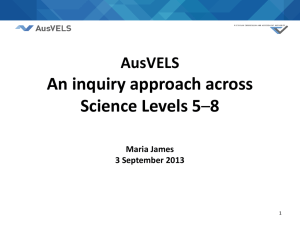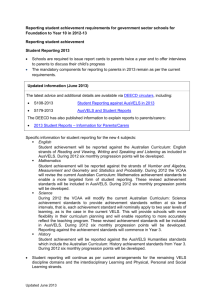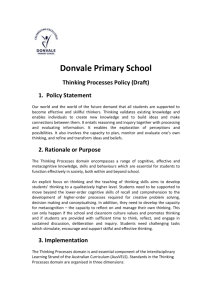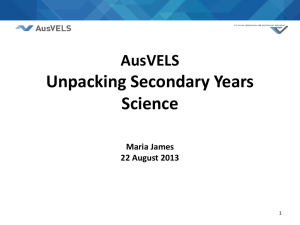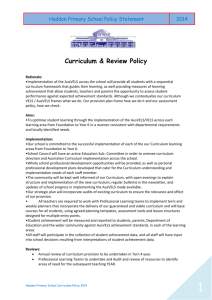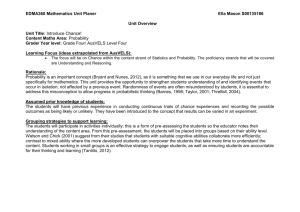AusVELS Science presentation F to 10
advertisement
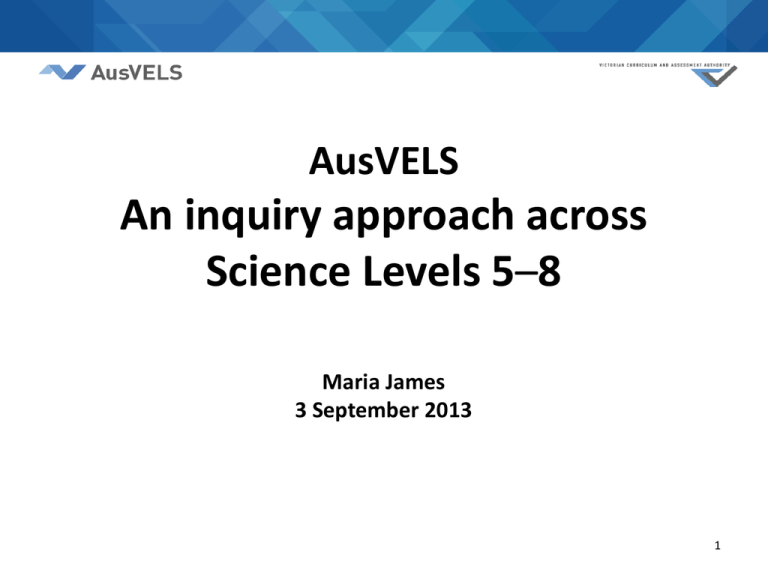
AusVELS An inquiry approach across Science Levels 5–8 Maria James 3 September 2013 1 Session aims • To share ideas in developing a sample snapshot unit/sequence of lessons for Years 5–8 based on generation of questions (an important element of an inquiry approach to science learning) • To share ideas in planning a sample snapshot unit of work integrating the three strands of the AusVELS Science curriculum (SU, SIS and SHE) 2 Question Use the ‘vote’ button to indicate whether you are primarily interested in: a) b) c) Levels 5 & 6 Levels 7 & 8 Levels 5–8 3 Where can I find AusVELS? VCAA websites AusVELS curriculum website: http://ausvels.vcaa.vic.edu.au/ AusVELS resources and support website: http://www.vcaa.vic.edu.au/Pages/foundation1 0/curriculum/index.aspx 4 Inquiry-based curriculum Levels F–4 Level 5-6: With guidance, select appropriate investigation methods to answer questions or solve problems … decide which variable should be changed and measured in fair tests The Australian Curriculum: Science emphasises inquiry-based teaching and learning Teacher driven inquiry Semi structured inquiry Student driven inquiry Opportunities for student-led open inquiry should be provided within each phase of schooling Level 7–8: Collaboratively and individually plan and conduct a range of investigation types … in fair tests, measure and control variables, and select equipment to collect data with accuracy appropriate to the task Levels 9–10 5 A model for examining ideas about inquiry 1. Level of integration of skills and domain knowledge: • Skills taught as separate unit ‘the scientific method’ • Science skills used to reinforce application of knowledge • Content and skills integrated through the unit • Context provided for content and skill integration 2. Level of student direction or choice/level of scaffolding needed: Prescribed processes independent task • Focus on reasoning ability • Focus on identifying variables • Assessing evidence and developing understanding • Report writing 6 Age-relevant curriculum Curriculum focus • Foundation – Level 2: awareness of self and the local world • Levels 3 – Level 6: recognising questions that can be investigated scientifically and investigating them • Levels 7 – 10: explaining phenomena involving science and its applications 7 Stimulus material – e.g. media articles Sharks? No need to cry for kelp, says ocean expert Lawrence Money The Age Tuesday September 3, 2013 p.8 8 “Sharks? No need to cry for kelp, says ocean expert” …Aquatic scientist Sheree Marris (has) good news…there are lots more sharks…“It’s a great sign…Sharks are top food-chain predators and increased numbers in the protected areas is a healthy sign”… “They don’t eat you…You have more chance of being killed by a toaster, a horse or a vending machine.” …Marris…says more than 60 marine parks have been set up in the Philippines in the past 10 years and they are monitored by international volunteers. The reason: fish are the prime food source for most of the population and the protected waters help swell the number and diversity, leading to better fishing in the adjacent waters. …“One of the big challenges facing Port Phillip Bay is that people think it’s a marine wasteland. They don’t realise what an incredible asset we have on our doorstep. It rivals the tropical reefs in colour and diversity. Eighty per cent of the marine life found here on the southern shores are found nowhere else in the world. You compare that to the overglamorised Great Barrier Reef where only 15 per cent is unique.” …(Matters) says most Melburnians would be amazed at the corals, kelp forests, sponge gardens, seagrass meadows and rocky reefs that lay beneath the waters of the bay. 9 Generating questions Activity: What questions does the stimulus material lead you to ask? 10 Science Understanding strand: content descriptions Level 5 • Living things have structural features and adaptations that help them to survive in their environment • Solids, liquids and gases have different observable properties and behave in different ways • Light from a source forms shadows and can be absorbed, reflected and refracted Level 6 • The growth and survival of living things are affected by the physical conditions of their environment • Changes to materials can be reversible, such as melting, freezing, evaporating; or irreversible, such as burning and rusting • Sudden geological changes or extreme weather conditions can affect Earth’s surface Level 7 • There are differences within and between groups of organisms; classification helps organise this diversity • Interactions between organisms can be described in terms of food chains and food webs; human activity can affect these interactions • Mixtures, including solutions, contain a combination of pure substances that can be separated using a range of techniques • Change to an object’s motion is caused by unbalanced forces acting on the object • Earth’s gravity pulls objects towards the centre of the Earth Level 8 • Multicellular organisms contain systems of organs that carry out specialised functions that enable them to survive and reproduce • Sedimentary, igneous and metamorphic rocks contain minerals and are formed by processes that occur within 11 Earth over a variety of timescales Refining questions Science Understanding • Biological sciences • Chemical sciences • Earth and space sciences • Physical sciences Activity: How can looking across the sub-strands of the Science Understanding strand provide breadth and depth? 12 Science as a Human Endeavour Sub-strand: Use and influence of science Levels 5 & 6 • Scientific understandings, discoveries and inventions are used to solve problems that directly affect peoples’ lives • Scientific knowledge is used to inform personal and community decisions Levels 7 & 8 • Science and technology contribute to finding solutions to a range of contemporary issues; these solutions may impact on other areas of society and involve ethical considerations • Science understanding influences the development of practices in areas of human activity such as industry, agriculture and marine and terrestrial resource management 13 Science as a Human Endeavour Sub-strand: Nature and development of science Levels 5 & 6 • Science involves testing predictions by gathering data and using evidence to develop explanations of events and phenomena • Important contributions to the advancement of science have been made by people from a range of cultures Levels 7 & 8 • Scientific knowledge changes as new evidence becomes available, and some scientific discoveries have significantly changed people’s understanding of the world • Science knowledge can develop through collaboration and connecting ideas across the disciplines of science 14 Refining questions Science as a Human Endeavour • Nature and development of science • Use and influence of science Activity: How can consideration of the Science as a Human Endeavour strand enhance science lesson/unit planning? 15 Science Inquiry Skills Questioning and predicting Levels 5 & 6 With guidance, pose questions to clarify practical problems or inform a scientific investigation, and predict what the findings of an investigation might be Levels 7 & 8 Identify questions and problems that can be investigated scientifically and make predictions based on scientific knowledge 16 Science Inquiry Skills Processing and analysing data and information Levels 5 & 6 • Construct and use a range of representations, including tables and graphs, to represent and describe observations, patterns or relationships in data using digital technologies as appropriate • Compare data with predictions and use as evidence in developing explanations Levels 7 & 8 • Construct and use a range of representations, including graphs, keys and models to represent and analyse patterns or relationships, including using digital technologies as appropriate • Summarise data, from students’ own investigations and secondary sources, and use scientific understanding to identify relationships and draw conclusions 17 Other resources related to oceans? 18 Assessment “ … the fundamental purpose of assessment is to establish where learners are in their learning at the time of assessment.” Masters G (2013), ‘Reforming Educational Assessment: Imperatives, principles and challenges’, Australian Education Review, 5-6 19 Measuring achievement Achievement Standards (available on the AusVELS curriculum website) Progression points examples (available on the AusVELS Resources and Support website) 20 Progression point examples • Assist teachers in the assessment and reporting of student achievement. • In AusVELS, the progression point examples are provided in 0.5 increments. Progression point examples are designed to: Progression point examples are NOT designed to: • illustrate how a student might show evidence of progression • be used in conjunction with other tools such as annotated student work samples • be modified by schools so that the examples reflect the curriculum structure and timing of when knowledge and skills are taught and assessed • replace standards • be used as a definitive or mandated set of progression measures for student assessment • be the only resource used by teachers to assign progression points on student reports 21 Measuring achievement: Science inquiry skills SIS Progression point 4.5: collect data systematically SIS Progression point 5.0: collect data systematically and begin to draw reasonable conclusions from the data. SIS Progression point 5.5: collect data systematically and analyse data to identify some relationships between variables and to draw reasonable conclusions Level 6 SIS Achievement standard: They construct tables and graphs to collect and organise their data, and to identify and analyse patterns and relationships. SIS Progression point 6.5: systematically collect, and accurately record, experimental data SIS Progression point 7.0: analyse and interpret collected and recorded experimental data, consistent with investigation aims SIS Progression point 7.5: comment on the validity of conclusions drawn from experimental data Level 8 SIS Achievement standard: Students summarise data from different sources and construct representations of their data to reveal and analyse patterns and trends, and use these when justifying their conclusions . 22 Levels 5 & 6 achievement: Science as a Human Endeavour SHE Progression point 4.5: explain how the work of a particular Australian scientist has benefited society SHE Progression point 5.0: explain how scientific collaboration has led to developing knowledge about, or solutions to, science-related problems SHE Progression point 5.5: compare different approaches to developing scientific knowledge or solving a scientific problem, including the role of scientific debate Level 6 SHE achievement standard: Students explain how scientific knowledge develops from many people’s contributions and how scientific understandings, discoveries and inventions affect peoples’ lives. 23 Levels 7 & 8 achievement: Science Understanding SU Progression point 6.5: use a range of provided simple dichotomous keys to identify a set of living and/or non-living things. SU Progression point 7.0: create a dichotomous key to classify a set of provided living and/or non-living things SU Progression point 7.5: use a five-kingdom taxonomic classification key to identify, distinguish between and give the scientific names of a range of living organisms Level 8 SU achievement standard: They use dichotomous keys to identify and classify living things. They explain how living organisms can be classified into major taxonomic groups based on observable similarities and differences. 24 Contacts Maria James Curriculum Manager, Science Email: james.maria.m@edumail.vic.gov.au Telephone: 9032 1722 AusVELS Unit Email: vcaa.ausvels@edumail.vic.gov.au 25
